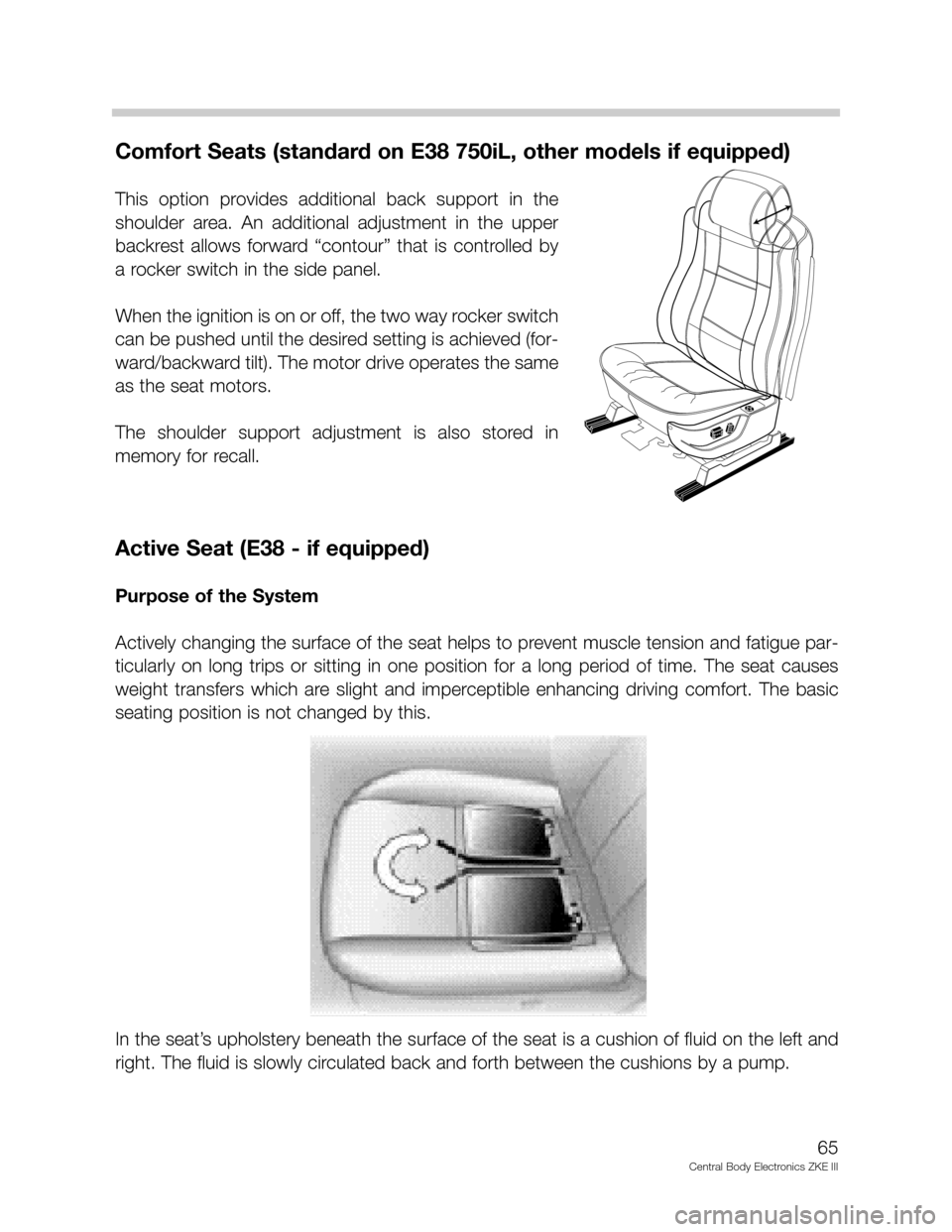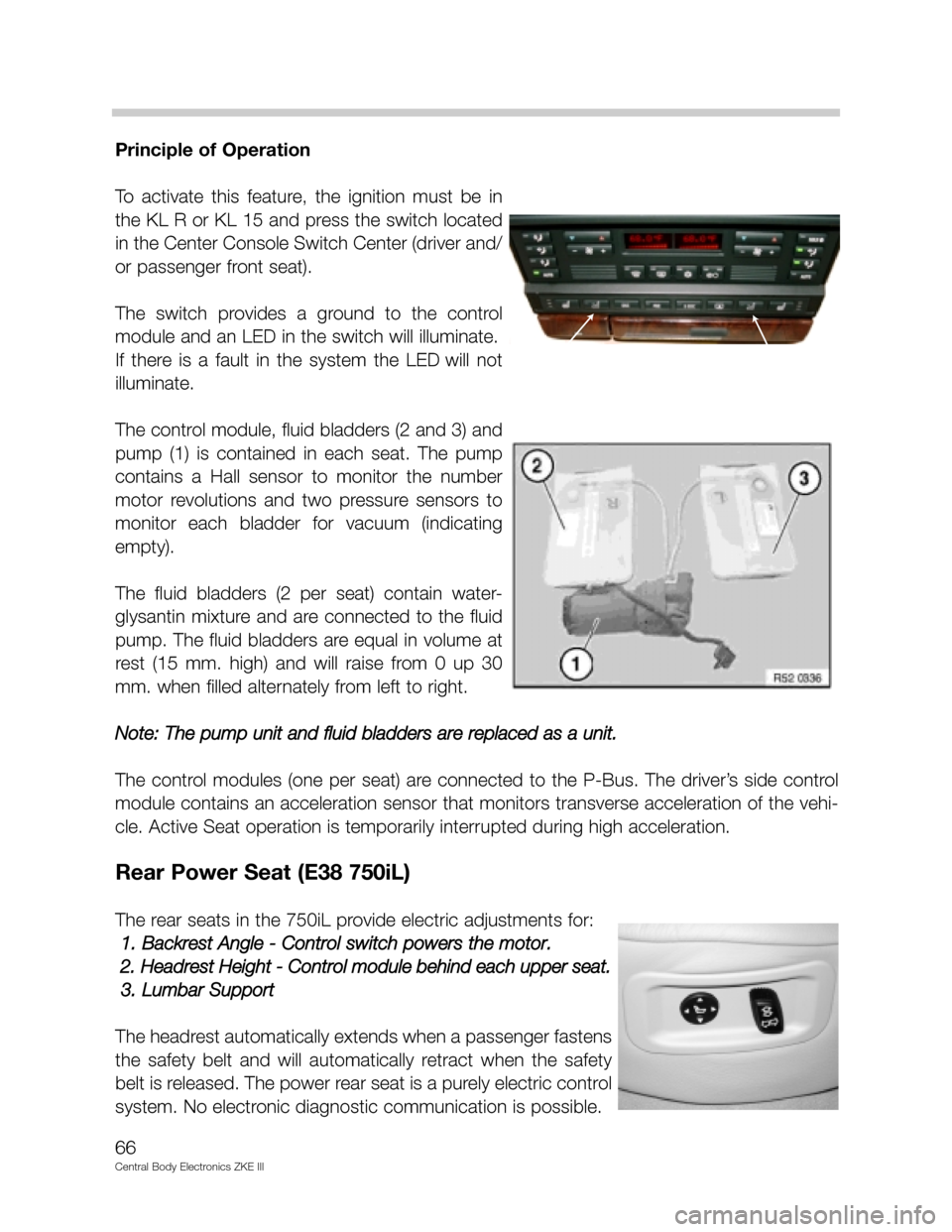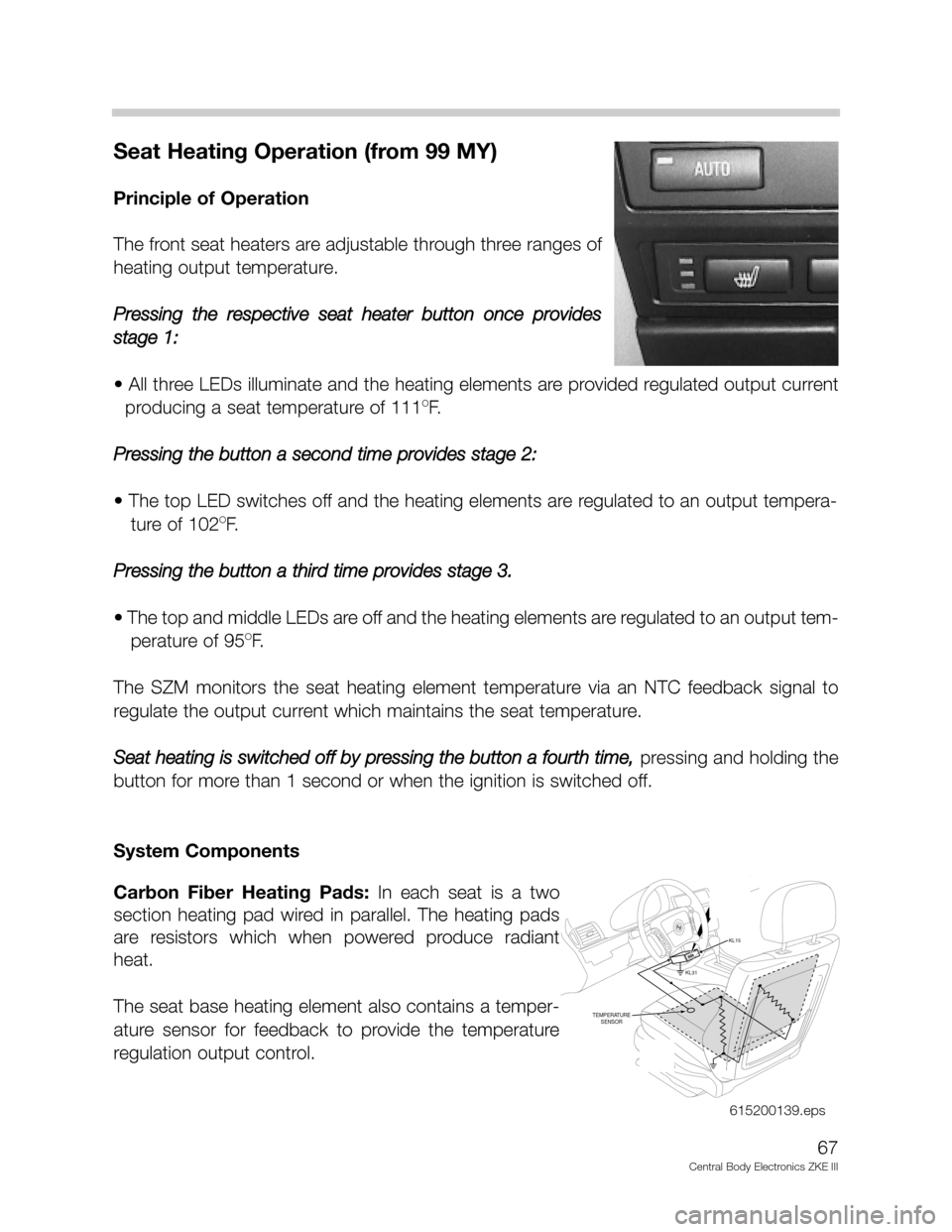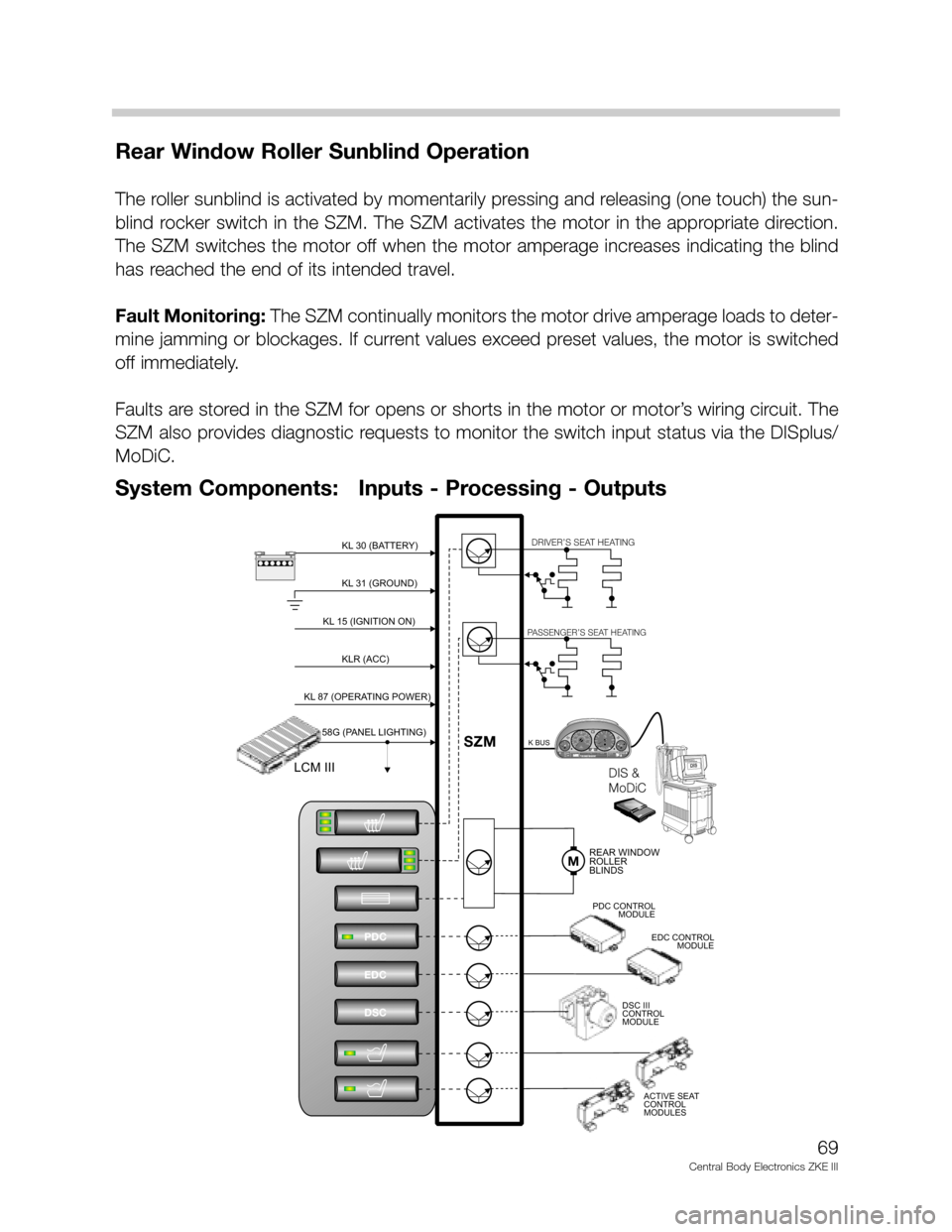1994 BMW 750IL ignition
[x] Cancel search: ignitionPage 65 of 80

Comfort Seats (standard on E38 750iL, other models if equipped)
This option provides additional back support in the
shoulder area. An additional adjustment in the upper
backrest allows forward “contour” that is controlled by
a rocker switch in the side panel.
When the ignition is on or off, the two way rocker switch
can be pushed until the desired setting is achieved (for-
ward/backward tilt). The motor drive operates the same
as the seat motors.
The shoulder support adjustment is also stored in
memory for recall.
Active Seat (E38 - if equipped)
Purpose of the System
Actively changing the surface of the seat helps to prevent muscle tension and fatigue par-
ticularly on long trips or sitting in one position for a long period of time. The seat causes
weight transfers which are slight and imperceptible enhancing driving comfort. The basic
seating position is not changed by this.
In the seat’s upholstery beneath the surface of the seat is a cushion of fluid on the left and
right. The fluid is slowly circulated back and forth between the cushions by a pump.
65
Central Body Electronics ZKE III
Page 66 of 80

Principle of Operation
To activate this feature, the ignition must be in
the KL R or KL 15 and press the switch located
in the Center Console Switch Center (driver and/
or passenger front seat).
The switch provides a ground to the control
module and an LED in the switch will illuminate.
If there is a fault in the system the LED will not
illuminate.
The control module, fluid bladders (2 and 3) and
pump (1) is contained in each seat. The pump
contains a Hall sensor to monitor the number
motor revolutions and two pressure sensors to
monitor each bladder for vacuum (indicating
empty).
The fluid bladders (2 per seat) contain water-
glysantin mixture and are connected to the fluid
pump. The fluid bladders are equal in volume at
rest (15 mm. high) and will raise from 0 up 30
mm. when filled alternately from left to right.
Note: The pump unit and fluid bladders are replaced as a unit.
The control modules (one per seat) are connected to the P-Bus. The driver’s side control
module contains an acceleration sensor that monitors transverse acceleration of the vehi-
cle. Active Seat operation is temporarily interrupted during high acceleration.
Rear Power Seat (E38 750iL)
The rear seats in the 750iL provide electric adjustments for:
1. Backrest Angle - Control switch powers the motor.
2. Headrest Height - Control module behind each upper seat.
3. Lumbar Support
The headrest automatically extends when a passenger fastens
the safety belt and will automatically retract when the safety
belt is released. The power rear seat is a purely electric control
system. No electronic diagnostic communication is possible.
66
Central Body Electronics ZKE III
Page 67 of 80

67
Central Body Electronics ZKE III
Seat Heating Operation (from 99 MY)
Principle of Operation
The front seat heaters are adjustable through three ranges of
heating output temperature.
Pressing the respective seat heater button once provides
stage 1:
• All three LEDs illuminate and the heating elements are provided regulated output current
producing a seat temperature of 111
OF.
Pressing the button a second time provides stage 2:
• The top LED switches off and the heating elements are regulated to an output tempera-
ture of 102
OF.
Pressing the button a third time provides stage 3.
• The top and middle LEDs are off and the heating elements are regulated to an output tem-
perature of 95
OF.
The SZM monitors the seat heating element temperature via an NTC feedback signal to
regulate the output current which maintains the seat temperature.
Seat heating is switched off by pressing the button a fourth time,
pressing and holding the
button for more than 1 second or when the ignition is switched off.
System Components
Carbon Fiber Heating Pads:In each seat is a two
section heating pad wired in parallel. The heating pads
are resistors which when powered produce radiant
heat.
The seat base heating element also contains a temper-
ature sensor for feedback to provide the temperature
regulation output control.
KL31
KL15
TEMPERATURE
SENSOR
615200139.eps
Page 69 of 80

Rear Window Roller Sunblind Operation
The roller sunblind is activated by momentarily pressing and releasing (one touch) the sun-
blind rocker switch in the SZM. The SZM activates the motor in the appropriate direction.
The SZM switches the motor off when the motor amperage increases indicating the blind
has reached the end of its intended travel.
Fault Monitoring: The SZM continually monitors the motor drive amperage loads to deter-
mine jamming or blockages. If current values exceed preset values, the motor is switched
off immediately.
Faults are stored in the SZM for opens or shorts in the motor or motor’s wiring circuit. The
SZM also provides diagnostic requests to monitor the switch input status via the DISplus/
MoDiC.
69
Central Body Electronics ZKE III
KL 31 (GROUND)KL 31 (GROUND)
DIS
DIS
BMWDIS
B
M
WD
I
S
BMWDIS
BMW
DIS
D
ia
g
n
o
s
e
-
a
n
d
In
fo
r
m
a
ti
o
n
S
y
s
t
e
mDIS &
MoDiCDIS &
MoDiC
M
o
Di
C
0½
CHECK
ENGINE
CHECK
ENGINEOIL SERVICEOIL SERVICEINSPECTIONINSPECTIONP
1/min
x1000km/hELECTRONICMPH1
2020404060608080100180160140 1201002001202201402400234
5
6
7!!ABS20 DIGIT READOUT20 DIGIT READOUT
123456
prnd432
m
prnd432
m
122.4 +72.0 fo
+72.0 fomiles0
10
15 20 40
KL 30 (BATTERY)KL 30 (BATTERY)-+
KL 15 (IGNITION ON)KL 15 (IGNITION ON)
KLR (ACC)KLR (ACC)
KL 87 (OPERATING POWER)KL 87 (OPERATING POWER)
58G (PANEL LIGHTING)58G (PANEL LIGHTING)
LCM IIILCM III
PDC
EDC
DSC
MREAR WINDOW
ROLLER
BLINDSREAR WINDOW
ROLLER
BLINDS
DRIVER’S SEAT HEATINGDRIVER’S SEAT HEATING
PASSENGER’S SEAT HEATINGPASSENGER’S SEAT HEATING
K BUSK BUS
PDC CONTROL
MODULEPDC CONTROL
MODULE
EDC CONTROL
MODULEEDC CONTROL
MODULE
SZMSZM
DSC III
CONTROL
MODULEDSC III
CONTROL
MODULE
ACTIVE SEAT
CONTROL
MODULESACTIVE SEAT
CONTROL
MODULES
System Components: Inputs - Processing - Outputs
Page 71 of 80

71
Central Body Electronics ZKE III
System Components: Inputs - Processing - Outputs
Entry/Exit Aid
The Steering Column Memory provides the feature of raising the steering column to ease
in exiting the vehicle and return it to the previous position after the vehicle is entered.
Raising the Steering Column:
Lowering the Steering Column:
• The ignition is switched “off”. • The ignition is switched to KL 15.
• The ignition is switched to KL R • The Handbrake is released or the door is closed.
and the driver’s door is opened.
• The ignition is switched to KL 15, The steering column recall movement can be inter-
driver’s door open with the hand- rupted at any time by tapping the adjusting lever.
brake applied.
Page 75 of 80

General Functions of ZKE III
Consumer Cut Off
The Consumer Cut Off function interrupts battery voltage to circuits preventing inadvertent
battery drain if one of these consumers were to remain activated. Circuits controlled by
consumer cut off will be switched off as the GM enters into the sleep mode.
For example, the interior lights are connected to the consumer cut out circuit (KL 30) and
can remain on if one of the control switches are left on. The consumer cut off will deacti-
vate KL 30 to the interior lighting after 16 minutes (or with the DISplus/MoDIC).
The following circuits are con-
trolled by consumer cut off:
• Map/Reading Lights
• Glove Box/Luggage Compart-
ment Lights
• Transmission Range Indicator
Light
• Overload Protection Relay for
- Power Seat Motors
- Steering Column Motors
Overload Protection
The seat and steering column motors receive
operating power through the consumer cutoff/
overload protection relay module. The consumer
cutoff signal from the GM signals the relay to
maintain operating power to the consumers.
If the relay module detects an increase in amper-
age (overload) the relay will open. The relay mod-
ule (K-72) is located in the electrical carrier
behind the glove box. The relay is reset by
switching the ignition “off” for 16 minutes, dis-
connecting the relay or the DISplus/ MoDIC.
75
Central Body Electronics ZKE III
E38 Shown
Overload
Protection Relay
Module
Page 76 of 80

Sleep Mode
To lower the constant battery draw when the vehicle is parked, the complete ZKE system
will go into the “Sleep Mode” 16 minutes after the ignition has been switched off and no
further ZKE function is active.
For example, the approximate E39 (528i) Battery draw is:
• Ignition switch off = approx 750 mA.
• One minute after = approx. 560 mA.
• After 16 minutes (sleep mode) = approx. 18 mA.
All modules in the ZKE system will go into the sleep mode. The P-Bus remains active, how-
ever no data transfer takes place until a wake-up request is received. The general module,
door modules or keyless remote module can wake the system up and put the ZKE back
on line. The K-Bus is active (high) in the sleep mode.
Sleep Mode Criteria:
KL R, KL 15 OFF and no further function activated for 16 minutes.
Wake Up Criteria:
KL R or 15 “ON” or a change in one of the signals listed below.
76
Central Body Electronics ZKE III
SIGNAL ACTIVITY ORIGINATING
MODULE
K-BUS High General Module
Door jamb switches (possibility of 4) Low “
Trunk lid lock cylinder microswitch High “
Trunk lid pushbutton microswitch Low “
Interior Trunk lid pushbutton microswitch Low “
Central locking button Low “
Hood microswitch Low “
Trunk Lid microswitch Low “
Interior light switch Low “
FIS sensor Low “
Tilt Alarm sensor Low “
FBZV operational signal High FBZV Module
Driver’s door lock microswitch - (lock) High PM-FT/SB
“ “ “ “ - (unlock) High “
Passenger door lock microswitch - (lock) High PM-BT
“ “ “ “ - (unlock) High “
Page 77 of 80

Battery Status
The GM monitors KL R on a dedicated circuit. If the ignition is switched on and detected
via the KL R circuit but the GM does not receive KL R status via the K Bus, the GM mon-
itors the KL R voltage level. If after an additional 0.3 seconds there is no K Bus activity, the
GM initiates an emergency running program.
A substitute value for vehicle speed is used to allow the GM to operate certain functions.
The emergency running program will terminate if the GM detects a vehicle speed or KL R
status via the K bus.
Diagnosis/Troubleshooting
The GM contains an EEPROM fault memory. Diagnosis and troubleshooting is carried out
with the DISplus or MoDiC. The diagnostic link is through the Instrument cluster over the K
bus to the GM.
Notes: _______________________________________________________________________
_____________________________________________________________________________
_____________________________________________________________________________
_____________________________________________________________________________
_____________________________________________________________________________
_____________________________________________________________________________
_____________________________________________________________________________
_____________________________________________________________________________
_____________________________________________________________________________
_____________________________________________________________________________
_____________________________________________________________________________
_____________________________________________________________________________
_____________________________________________________________________________
_____________________________________________________________________________
_____________________________________________________________________________
_____________________________________________________________________________
77
Central Body Electronics ZKE III